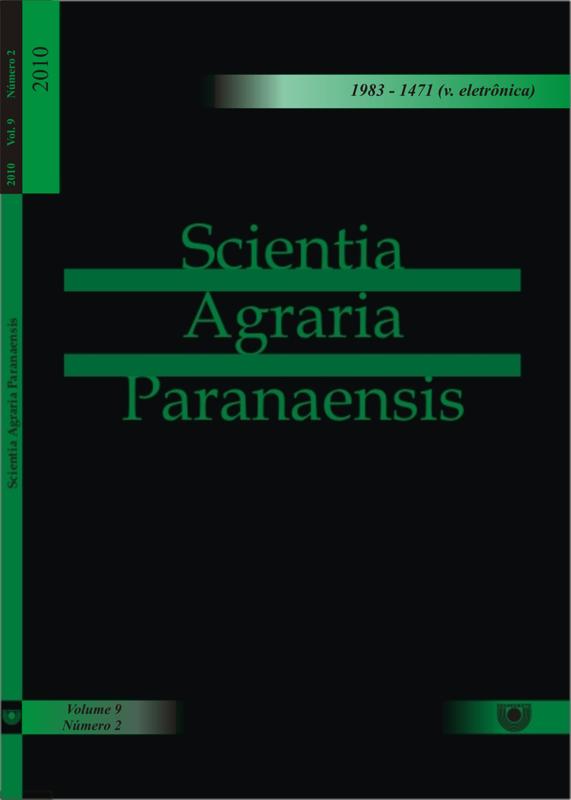Ação do herbicida alachlor na microbiota do solo, nodulação e rendimento de plantas de amendoim
DOI:
https://doi.org/10.18188/sap.v9i2.4579Palavras-chave:
Amendoim, herbicida, fixação biológica, microrganismosResumo
Objetivou-se avaliar o efeito do herbicida alachlor na nodulação e rendimento de dois genótipos de amendoim, bem como a população de bactérias e fungos e atividade microbiana do solo, em condições de campo. O delineamento experimental foi em blocos casualizados em esquema fatorial (2x4x4). Foram utilizados dois genótipos de amendoim (Vagem Lisa – G1 e Tatuí – G2) e quatro tratamentos, a saber: capina + semente inoculada (C+SI), capina + semente não inoculada (C+SNI), herbicida + semente inoculada (H+SI), herbicida + semente não inoculada (H+SNI), com quatro repetições, totalizando 32 parcelas. O herbicida alachlorfoi aplicado em cobertura na dose de 6 L ha -1 do produto comercial. A semeadura foi realizada em parcela experimental de 17,5 m2. Aos 42 e 56 dias após a emergência (DAE) foram
determinados o número e massa seca dos nódulos. O rendimento de grãos e a quantificação de fungos e bactérias foram determinados aos 84 DAE. A atividade microbiana foi monitorada
quinzenalmente, durante 84 dias. O rizóbio introduzido (Bradyrhizobium japonicum) não foi eficiente para competir com a população indígena no processo de nodulação. A presença do
herbicida aumenta a população de bactérias e a atividade microbiana do solo. O genótipo Tatuí apresenta rendimento superior ao Vagem Lisa apenas no tratamento herbicida com
inoculação.
Downloads
Publicado
01-01-2000
Como Citar
PEIXOTO, M. S. F. P.; PEIXOTO, C. C.; SAMPAIO, L. S. V.; SAMPAIO, H. S. V.; SOUZA, R. A. S.; ALMEIDA, J. R. C. Ação do herbicida alachlor na microbiota do solo, nodulação e rendimento de plantas de amendoim. Scientia Agraria Paranaensis, [S. l.], v. 9, n. 2, p. p. 60–70, 2000. DOI: 10.18188/sap.v9i2.4579. Disponível em: https://e-revista.unioeste.br/index.php/scientiaagraria/article/view/4579. Acesso em: 24 dez. 2025.
Edição
Seção
Artigos Científicos
Licença
Aviso de Direito Autoral Creative Commons
Política para Periódicos de Acesso Livre
Autores que publicam nesta revista concordam com os seguintes termos:
1. Autores mantém os direitos autorais e concedem à revista o direito de primeira publicação, com o trabalho simultaneamente licenciado sob a Licença Creative Commons Attribution que permite o compartilhamento do trabalho com reconhecimento da autoria e publicação inicial nesta revista.2. Autores têm autorização para assumir contratos adicionais separadamente, para distribuição não-exclusiva da versão do trabalho publicada nesta revista (ex.: publicar em repositório institucional ou como capítulo de livro), com reconhecimento de autoria e publicação inicial nesta revista.
3. Autores têm permissão e são estimulados a publicar e distribuir seu trabalho online (ex.: em repositórios institucionais ou na sua página pessoal) a qualquer ponto antes ou durante o processo editorial, já que isso pode gerar alterações produtivas, bem como aumentar o impacto e a citação do trabalho publicado (Veja O Efeito do Acesso Livre).
Licença Creative Commons
Esta obra está licenciada com uma Licença Creative Commons Atribuição-NãoComercial-CompartilhaIgual 4.0 Internacional, o que permite compartilhar, copiar, distribuir, exibir, reproduzir, a totalidade ou partes desde que não tenha objetivo comercial e sejam citados os autores e a fonte.


